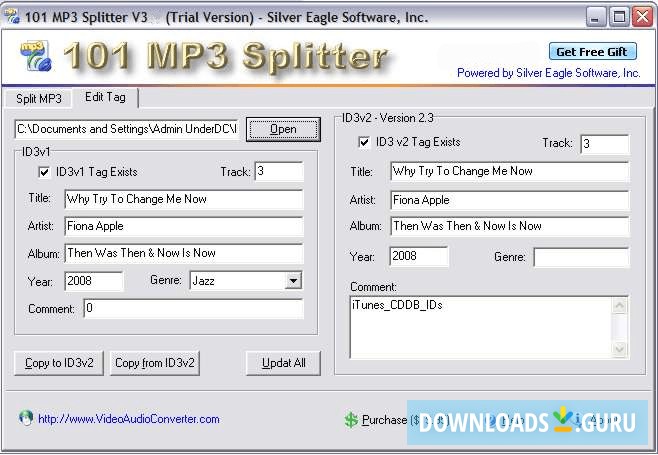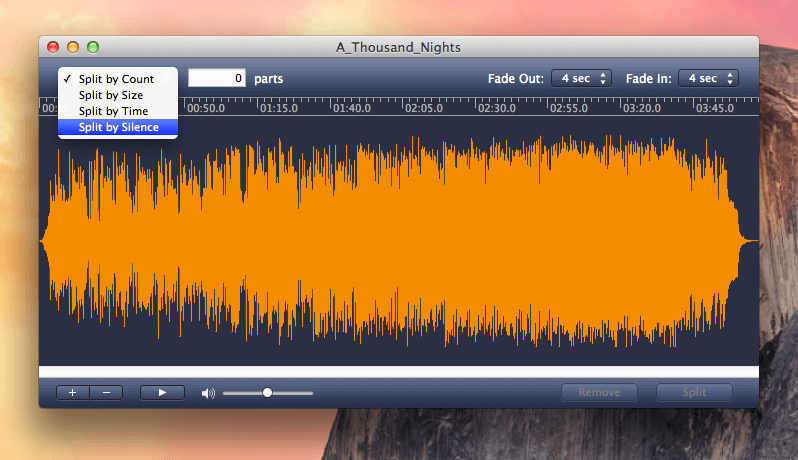

Related keywords: mp3, wav, splitter, cue, split, combine, cutter, cut, split mp3, mp3 splitter, wav cutter, wav split, wav splitter, cut at pauses, joiner, silence detection, mp3 cut, wav joiner, visual audio splitter, join, wav cut, split by cue, mp3 cutter, cue splitter, pause detection, mp3 joiner, wav combine, detection, mp3 combine, wav join, create cue, wma splitter, ape cutter, combine mp3, join mp3, ape, wma, pause, silence, visual, by, pauses, audio, at, create Active Audio Record Component. Numerous files can be processed as a batch. Split your files fast and without quality loss using the visual mode. Visual MP3 Splitter & Joiner 10.0 Visual MP3 Splitter & Joiner is an audio editor program with two modules: MP3/WAV splitter and WAV/MP3 joiner.


Available here:, and pasted below: #!/usr/bin/env python
#MP3 SPLITTER BREAK AT FIXED TIME TO NEAREST QUITE SPOT PLUS#
The start point for every command above after the first is the previous command's start point plus the previous command's duration.įaced the same problem earlier and put together a simple Python script to do just that (using FFMpeg). For example, many years ago there was a common practice with QuickTime files to compress the video with H.264 video but leave the audio as uncompressed PCM if you ran across such a file today, you could modernize it with -c:v copy -c:a aac to reprocess just the audio stream, leaving the video untouched. You would use the more verbose style when you want to copy only one of the streams, but re-encode the other. For simple A/V programs, it is equivalent to the more verbose flags -c:v copy -c:a copy or the old-style flags -vcodec copy -acodec copy. The -c copy argument tells it to copy all input streams (audio, video, and potentially others, such as subtitles) into the output as-is. Just pass the natural cut point offsets to ffmpeg, telling it to pass the encoded A/V through untouched by using the "copy" codec: $ ffmpeg -i source.m4v -ss 0 -t 593.3 -c copy part1.m4v I think you should be using a video editor or player to find natural cut points just shy of 10 minutes apart.Īssuming your file is in a format that YouTube can accept directly, you don't have to reencode to get segments. That will put cuts right in the middle of sentences, even words. You pay for the latter with a certain complexity.Īll that aside, I don't think you really want to be cutting at exactly 10 minutes for each clip. The linked article describes fast-but-inaccurate and slower-but-still-accurate alternative formulations. Where I have it now is slow but accurate. Wrapping this up into a script to do it in a loop wouldn't be hard.īeware that if you try to calculate the number of iterations based on the duration output from an ffprobe call that this is estimated from the average bit rate at the start of the clip and the clip's file size unless you give the -count_frames argument, which slows its operation considerably.Īnother thing to be aware of is that the position of the -ss option on the command line matters. $ ffmpeg -i source-file.foo -ss 1200 -t 600 third-10-min.m4v $ ffmpeg -i source-file.foo -ss 600 -t 600 second-10-min.m4v $ ffmpeg -i source-file.foo -ss 0 -t 600 first-10-min.m4v


 0 kommentar(er)
0 kommentar(er)
